***If you have a dog, know someone with a dog, have been to Europe or plan on it, I’m urging you to read this post both for your own safety and the safety of any dogs in your life. Thank you. ***
Something incredibly scary happened the other day while Dagny and I were out on our walk. We encountered some strange caterpillars that I’ve now found out are extremely dangerous to dogs. They are called pine processionary caterpillars and aren’t common in the USA. At the time I didn’t know any better, but now I do and I’m telling you.
Think these pine processionary caterpillars are some weird things we found in the forest? Nope! They were walking across a sidewalk here in a residential area and could have killed Dagny… and the issue isn’t from ingesting them. They can cause problems for dogs much more easily than that. If you or anyone you know has a dog and either lives in Europe or may visit (and possibly some areas of the US), please read on for my PSA (public service announcement). A dog’s life could depend on it.
Read on about pine processionary caterpillars in France and how they are dangerous for dogs!
Dangers of pine processionary caterpillars in France for dogs
NOTE: Dagny is now OK and I can type this without feeling like I want to throw up from the stress.
As a kid growing up, I remember learning about caterpillars in school and how the fuzzy little things would one day turn into a butterfly or maybe a moth depending on the species. We’d learn about their life cycle and how they’d inch along and basically do no harm. I remember petting them.
Never had I ever seen or heard about a species of caterpillar that is native to Western Europe called pine processionary caterpillars, a type of caterpillar that makes its nest in regular old pine trees. While all is well now, we had a very frightening run-in with hundreds of them last week and I want you to know about it.
Dagny and I walk every morning and pretty much take the same route. One day last week, the grassy area of a nearby apartment building that we walk through to go to the park caught my eye. I thought there were some branches on the sidewalk but then I realized these “branches” were moving.
I jumped back thinking the long thing I saw was a snake but upon further inspection, I realized what I was seeing was a giant chain of caterpillars. Never having seen anything like it, I bent down and snapped a picture of this giant chain of caterpillars spanning at least 20 feet that was trying to cross the road, all nose to tail. I then noticed more chains weaving in and out of the grass.
I even made a joke to myself about caterpillars going on vacation. The chains were weaving around from the street, up the curb, down the sidewalk and into the grass over to the trees. While I was snapping my pic, Dagny came over to investigate, stepped on the caterpillars (I know this because one balled up to protect itself) and sniffed them.
She realized they weren’t food and walked away. I took my photos in a total of 20 seconds max, and we continued on our way to the park. I posted the above pic on Instagram while walking because they were so unusual to me and I had never seen them before. (You can follow me in Instagram here.)
Shortly thereafter, a woman commented on my photo saying to be careful with my dog and that pine processionary caterpillars in France are dangerous.
I assumed she meant they were dangerous if ingested — some insects and critters can be — and I didn’t think much of it because I know Dagny isn’t one to eat random worms or bugs so I wasn’t worried. She goes for pieces of baguette or cookies that kids drop from their strollers. Not bugs.
When we got home, I googled caterpillars and dogs out of curiosity and my Google search results lit up like a Christmas tree with people’s horror stories (mostly in Spain & Portugal) of their dogs DYING after coming into contact with these pine processionary caterpillars. Officially called Thaumatopoea pityocampa, the innocuous-looking caterpillars most likely to be out and about from February to July and fall from white wool-like nests hanging in the pine trees.
They’re not good for the trees either and in Spain, these pests rank second as the most destructive pine tree plague, after forest fires. Yikes!
The scary part is that the hairs are the issue.
Just how dangerous are pine processionary caterpillars in France to dogs? Very.
Of course eating certain bugs can make you sick, but in the case of these pine processionary caterpillars and dogs, their little hairs are the issue and a dog doesn’t have to eat the actual caterpillar to become extremely ill or die. Just a single lick or prick from one of these venomous hairs can induce anaphylactic shock in small dogs and humans, extreme skin irritation and possibly death. It’s also common that if the dog licks the caterpillar or takes it in his mouth, that the tongue tissue will start to become necrotic, and if the dog lives, his tongue will have to be amputated.
Here’s what a Portuguese veterinary hospital had to say about these poisonous pests:
“Each hair is a sealed ampoule containing taumatopein. The hairs in turn end in a sharp point that can bury into their victims like ‘harpoons.’ The hair then bursts, liberating the toxin.”
What are the signs? They continue, “Swelling of the lips, muzzle and face and abundant drooling are the first signs. These can be followed by itching around the head, restlessness and constant rubbing of the muzzle and face on the ground. When contact with the tongue happens, there is serious inflammation and sloughing of the affected parts. As time goes by large sections of the tongue show ‘gangrene’ and eventually drop off.”
Keep in mind these are pests that make their nests on regular pine trees. Not some rare type of tree that you’d never encounter.
Pine trees are so common and I can’t believe the pine processionary caterpillars, so normal looking, are so dangerous.
What else is extremely scary about processionary caterpillars?
The wind. A gust of wind can blow the hairs into your dog’s fur (or in contact with a human’s skin) — Dagny is very hairy — and prick the dog’s skin long after you’ve left the site of the processionary caterpillars. The prick causes irritation leading the dog to lick at the area and ingest more toxins. Normally reactions happen very quickly but if a caterpillar hair is lurking in the dog’s fur, who knows when the dog will lick it.
Even long after the caterpillars are gone, tons of these toxic hairs are left in the nests so that when the wind blows or an exterminator comes, they can be transported and potentially irritate skin or mucous membranes even when people or animals have not directly come into contact with the caterpillars. I’m getting the heeby jeebies just typing this.
A call to the vet
So back to the story about these pine processionary caterpillars in France. At this point, Dagny was acting totally fine but I was starting to get really nervous about everything I read online. In the time between our walk and me realizing the caterpillars were a danger, she had been all around the house and even in our bed, possibly leaving caterpillar hairs all around.
Remember, I know she stepped on one and there were hundreds in the various caterpillar chains. Frantically, I asked Tom to call the vet while I put all our linens and blankets she had been on in the washer and hurriedly vacuumed the whole house in case she brought in a caterpillar hair (or if I did on my shoe).
So now a few hours had passed since the walk but the vet was concerned and said what she sees most commonly is a dog losing its tongue because of these caterpillars. Normally it’s best to thoroughly rinse (but don’t rub, to avoid bursting any of the hairs) the dog’s fur and mouth right after coming into contact with the pests but I didn’t know at the time.
The vet said to put on gloves and wash Dagny’s mouth and paws really well just in case. We did that, as I blamed myself for not knowing about these bastards, and as we were drying her, Tom found a tuft of caterpillar hair in her tail. We lobbed off a chunk of tail hair not taking any chances and put the toxic hairs in a bag, hazmat style to dispose of later.
After we dried her off, we brought her to see the vet for an exam. Better safe than sorry. The vet said her mouth looked OK for now but that sometimes the reaction is delayed depending on when she came in contact with the hairs (if they were on her fur and she licked it after the walk or if one pricked her when she sniffed it). She asked me if I saw Dagny lick the caterpillar and I said no but I couldn’t be sure because I did look away to take the picture.
The vet took preventive measures just in case and gave Dagny cortisone and a dose for me to give her the day after. She’s still showing no signs of being affected by these horrid creatures at all and I’m so grateful we narrowly escaped what could have been a nightmare. We avoid the sidewalk where I spotted the caterpillars and I’m so thankful to lionath38 on Instagram for alerting me.
Anyone who truly knows me is fully aware that my dog is my life and if anything happened to her I’d never forgive myself. Never.
What now?
I asked Tom if he knew about the dangers of pine processionary caterpillars in France and if French people learn about them in school. He said he learned that caterpillars in general can cause painful skin reactions like rashes (kind of like a poison ivy type of reaction and his mom had a severe reaction growing up after one fell on her bare shoulder) but didn’t know anything specific about these processionary caterpillars that come down from pine trees.
We’re making a formal complaint with the mayor’s office this week and hoping they exterminate the nests or at least safely get rid of the caterpillars that are in our neighborhood. Or at the very least put up a sign.
As I said, this was not in the forest or park where you’d expect to find all kinds of creepy crawlies but in a residential neighborhood on the sidewalk next to an apartment building (that has pine trees planted near the parking lot). I also told all the dog owners I know in the neighborhood to avoid that area and now I’m telling you.
Here’s Dagny snooping around in the yard after her encounter with the processionary caterpillars:
To wrap up, keep an eye out for pine processionary caterpillars in France and just keep your dog away from all caterpillars wherever you live to be safe. Tell everyone you know whether they’re in Europe or not. I wish I had known about these pine processionary caterpillars ahead of time, so please spread the word to prevent a dog (or human) from becoming sick or worse.
Ever seen pine processionary caterpillars in France or where you live? Has your dog encountered them?
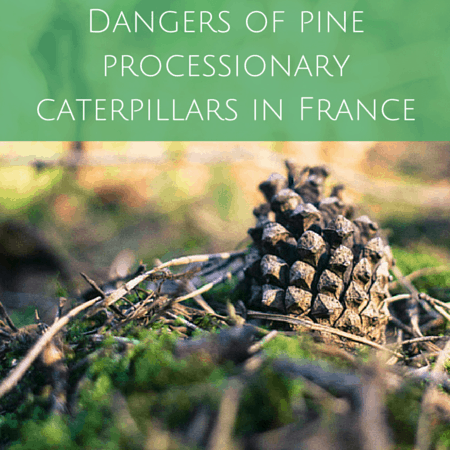
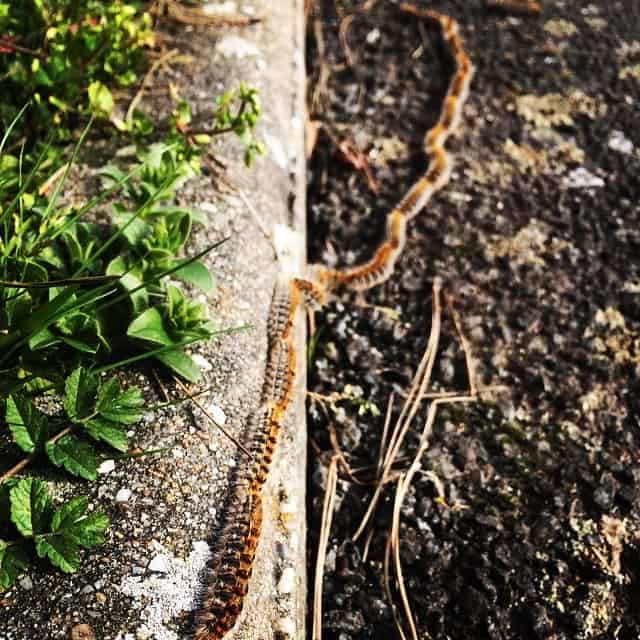
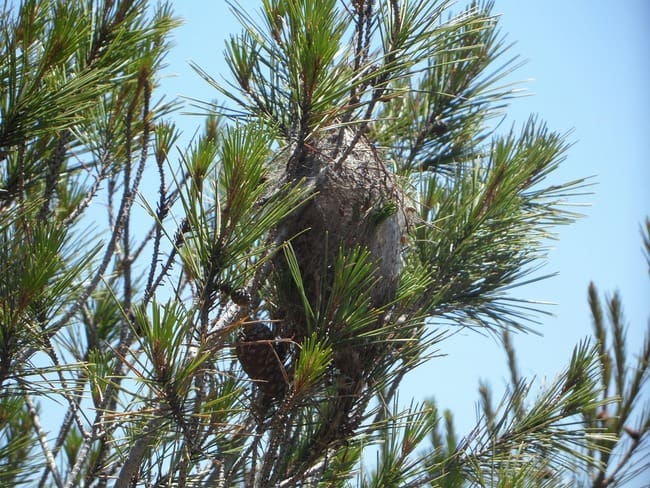
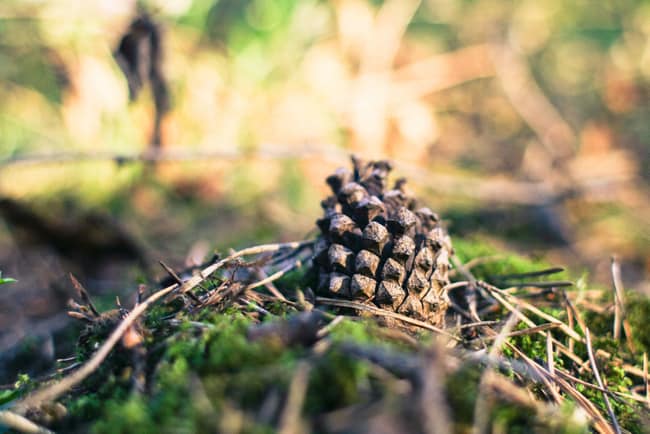




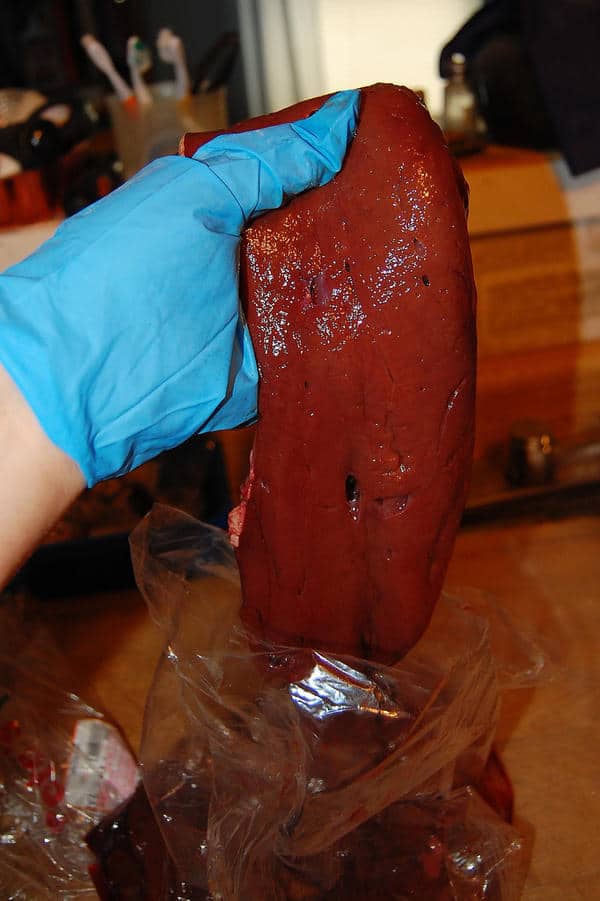


OMFG, if I had seen that (or many of those) I would have run screaming back to my house! (I hate worms and anything slimy like snails … and caterpillars, but oddly not snakes) SOOOOO glad Dagny is ok!
It really was a strange sight to see. When I got down low to look at them, they were just innocent little caterpillars but so glad I didn’t touch them because as it turns out they’re far from innocent. Ewwwww. Thank you 😉
Thanks for the info! Scary!
You’re welcome. Spread the word!
That’s insane. I didn’t know about that either. I don’t know if we have those in the U.S. but always good to know. I would have inspected too. I know my husband would have been fascinated to see something like that & if we had our baby, Charlie Brown, with us, who knows what he would have done. Thanks for the heads up.
It really is nuts. Of course we hear about regular ants and then fire ants or regular bees and then huge wasps and other variations of relatively safe creatures. But dangerous caterpillars from pine trees? Never would have thought they were dangerous. Thanks for reading the post!
Thanks for educating us to the dangers of this caterpillar.
You’re welcome and thanks for reading. Please spread the word!
So that’s what those big cotton ball-like things are in the trees! I moved to Spain 6 months and have been curious about what they were (everywhere here in Northern Spain and unexistent in Canada, so I never knew). I have to admit I’m not relieved though! Thanks for helping me figure it out, and I’m glad to hear that your puppy is safe!
Yup, VERY popular in Spain too so stay away from the nests especially on windy days! You’d think landscaping companies would stop planting these trees prone to pests, right? Keep your eyes open if you go walking around — the ones I encountered were on a regular old sidewalk! ICK!! Thank you for checking out the post!
I have never heard of these caterpillars before. Thanks for the warning!
Scary, right? I’m googling “dangers to dogs in France” so I can keep an eye out for anything I’m not familiar with going forward. But happy to spread the word. Thanks for taking the time to read my post!
My-laws, who live in the French Alps, had major problems with these caterpillars. They bought a house there with a pool in the garden surrounded by beautiful pine trees. Little did they know…
They battled them for years. They tried to go up in the trees and cut the nests down (they would call professionals to do this), but the caterpillars just kept coming back. They tried to burn the caterpillars, but their skin swelled and itched so badly that they had to stop.
Finally they had to cut down all their beloved trees and all of the people living in their town who had pine trees in their gardens cut down the trees as well.
They haven’t had any problems since.
Oh my gosh, what a nightmare that must have been for them. I think it’s for the best that they had the trees removed. Not worth the hassle and danger. Imagine running through the yard in bare feet? I can’t even go there. Ouch. Thanks for sharing the story! I think palm trees are the way to go 😉
I’s so glad that Dagny’s OK! How scary! Suddenly I’m grateful that the worst thing that my dogs face here in northern Michigan are ticks. I can’t imagine having to worry about little caterpillar hairs that are hard to see! I hope the two of you never see another one of those caterpillars while you’re on your walks. Sharing this info is a great idea. A dog’s life may be saved.
Thank you, it really was quite the scare. You know me, Christine, so I’m sure you could imagine. Ticks are no joke either, though. I hope we never see caterpillars or ticks ever again. Thanks again for reading
Hi, Well done for writing about this and letting people know. Yes we have these in the Charente Maritime. I first encountered them some years ago down in Pyrenees Atlantique and, like you, at the time did not know what they were, the neighbours told us. When we moved here we had one very scraggly pine tree in the garden, it was covered in their nests, we had no choice but to take the tree down, fortunately it was ugly and not in good health and so the tree was not missed at all.
Thank you for taking the time to read. No one I’ve asked in the US knows a thing about them and even French people know about caterpillars but not super-dangerous processionary ones. So glad your neighbor informed you and you cut the tree down. Better off!
Diane, this story is so timely as I just had a an expat friend in Lyon area who wasn’t aware of these caterpillars and her dog had a terrible reaction just like described in your posting. Luckily she got him to vet in time and he is now recovered. However, it is so scary as it sounds hard to avoid them. I now worry for my young children innocently playing outside! I will be obsessively looking for the nests and trails whenever we go to play.
Oh wow, so glad her dog is OK and she was able to get to the vet fast enough. My fear is for a dog to casually lick one or walk on a caterpillar and the owner either not seeing it or not thinking anything of a harmless little caterpillar and not knowing what’s causing the reaction. So much harder for the vet to diagnose. Thank goodness your friend’s dog is OK. I’m keeping my eyes peeled. Thanks for taking the time to read the post!
Not heard of these before – I like you would have assumed the harm was from eating them. Scary!
Glad I read this because if I ever had seen them I would have been taking lots of close up photos and my kids would have been jabbing at them curiously…and so on! You must be so relieved that your dog is okay.
Hi Diane, thanks for the warning. It’s not uncommon to see a procession of caterpillars just like that here in Greece and one area we walk the dogs is a wood like area filled with pine trees covered in those little furry nest things!
Thank you for raising awareness as I had no idea they could be so deadly, after all just like you I grew up petting furry caterpillar!
I am so glad that Dagney is fine and I’ll turn back the next time we come across a procession of caterpillars!
Thank you for the warning. We had no idea!
I have heard of these caterpillars although have never seen them in our part of Normandy. There is also an Oak Processionary caterpillar. I have read, though, that severe reactions to either, whilst horrendous, are not what happens to everyone … but still better to be safe than sorry. Also if you find live caterpillars or their nest you need to get a professional to deal with them.
Thank you for adding this cautionary tale to #AnimalTales and I am so glad Dagny is OK.
Just came across this post whilst looking the subject up. We don’t have these in the UK either, so I wasn’t aware of them until a neighbour asked me wasn’t I worried about the PPC, whilst I was unloading some recently bought pines to add to those already in our garden. Well I certainly am now! And am pleased Dagny is fine.
I don’t think we have the pines that they favour and I’ve read that it is good to plant PPC repulsive trees close by, such as willow and birch, so I’ll do that and I’m also adding some hoopoe attractive bird boxes. I’m trying prevention as the toxins to get rid of the PPC can kill your dog too – and I’m rather sensitive about that having lost mine to an unknown poison.
I am sitting, naked on the floor of my bedroom having just sprayed myself with a chemical agent. Why? Well because yesterday and today, I cut up some branches from a pine tree I have cut down. The branches were filled with pine tree processional caterpillars. I am covered in a rash and spots that the doctor can’t explain. He says they are caused either by contact with the caterpillar hairs, or else I have scabies! How medieval. Bienvenue en France.
Oh my gosh, Sidney, so sorry to hear that! What part of France are you in? The damn things are surprisingly common in France and I’ve heard stories like yours since writing this post about people just doing yard work and inhaling the hairs or inadvertently disrupting a nest. Are you in pain? I hope the treatment works. So sorry ;-(((
Hi, just read your post too late. Left my puppy with friends today whilst I sang with the church choir and when they took her for a walk she licked one! She’s pretty ill as it was several hours after the event that I went to fetch her. The vet has administered treatment for the inflammation but she’s likely to lose the tip of her tongue. Poor little thing is feeling dreadful. I knew about these PPC’s in the Charente Maritime and here in the south Landes but it’s pretty rare that they are out and about in January, so it’s a rather horrid shock. Apart from the vet’s treatment the only thing I can do is to wash her tongue copiously with cold water every half hour to give her some relief, and pray that her tongue is saved. Some of the blisters under her tongue have burst and she seems to be in slightly less pain. She’ll be on liquid food for at least a week. So great job with your post for those who don’t know. I’ll get my vet to put up big notices in both his surgeries for the anglophone community.
Aww, I’m so sorry to hear this. The caterpillars are really a problem in France and a neighbor in town told me he saw about 6 huge chains of them outside the post office (in January). The town doesn’t seem to take care of them. I’m always keeping an eye out. I hope your pup heals nicely and doesn’t lose a part of her tongue. Sorry again ;-(
Hi Diane, thanks. Vet’s advice if this happens to anyone else’s puppy or dog is – rinse copiously with cold water as soon as you can and keep on doing it and get to the vet pronto! Anyway, hope you’re enjoying life here despite the caterpillars. There;s some wonderful fauna and flora around here and it’s a joy to breathe real fresh air. All the best.
Hi, quick update. Puppy has lost end of her tongue, and is adapting to eating etc. without. Otherwise she has made a full recovery and today has started playing again. Have got Vet and local pharmacies to put up warning signs – they’re shocked the things are out so early. So basically a happy ending. Good luck to you Diane and thanks for a great blog, have read lots of your other entries. Impressive.
So glad to hear your pup is doing OK, despite losing the tip of her tongue. It’s really scary and I wish the towns did more to get rid of these pests. I hope your vet and pharmacy put up the signs. The apartment building management office did NOTHING when I went in to explain the dangers in their trees. So relieved you got a happy (ish) ending and thanks again for coming back to update me — and for checking out other posts. 😉 Enjoy your weekend!
Hi Diane – thanks for posting, my Italian Spinone had all the symptoms you’ve listed (drooling, panting, swollen tongue) so straight to the vets today for antibiotics, painkillers and 30mins of syringing with iced water mixed with bicarb of soda.
We’ve only been in France for a week (Montauroux) and it was only my posting on facebook this morning asking what this ‘convoy’ of catterpillars was that resulted in knowing how potentially dangerous they can be, then coming across this page on a google search.
The vets knew instantly what was happening and stressed how dangerous those caterpillars can be.
Malcolm
I’m so sorry that these pests have welcomed you and your dog to France. I really had no idea what they were either and now I warn everyone. I’m glad you caught it and got him to the vet. I hope everything heals and that he’ll be back to normal soon. Dreading spring because of the caterpillars. The nests are in all my neighborhood trees!
Iknew these caterpillars for having lived in the west of France where they are common. It’s an invasive specie, and is very difficult to get rid of. I heard somebody tell that burning is efficient (but dangerous in a forest)
Oh my god! Thank you so much for this post! How CREEPY and well…horrifying! This absolutely scares me…especially since all it takes is a little hair. I will be sure to be extra careful with Molly now. This worries me with hiking, now! Can my dog safely be off-leash on a hike without me fearing her death? What did the hairs on her tail look like?
Ah, I didn’t mean to scare you. While the caterpillars ARE serious, as long as you keep an eye out, everything should be fine. They are most common in spring months around here and you will definitely notice the long chains of them. If your dog does step on them or lick them, just act right away and get her to the vet. Don’t wait. They are dangerous but not usually lethal by any means so I didn’t mean to unnecessarily freak you out!
Most places require dogs to be on a leash so be sure you’re following the rules for wherever you are. Don’t let the prospect of caterpillars like these keep you from doing the things you love. 😉 They’re out there but as long as you’re vigilant, everything should be fine!
I live in the Italian Alps and we have Alpini Festas (festivals) there for many years I attended no problem. But last year after attending one I developed a strange rash the following 2 days and got worse after that. Finally my Italian cousin said what it was (caused by the Processionary Moth). I said gee thanks for telling me and wondered why no one had warned me before, as I am always in the forest there, not only at the festas but even in the forest we live by. Apparently, the locals are all aware of this and don’t think to alert anyone since it is already common knowledge they just assume everyone already knows.
This rash was painful and there was a slight fever and red large welt-like bumps broke out everywhere especially on the exposed areas like my chest, arms, and bottom of my back and legs. But it soon spread to even my butt and thighs and thank God it did not spread to my face.
It took about 2 weeks. to finally go away.
TABIANO SOAP (contains sulfur and tea tree oil you can buy in Italy or online on Amazon. This is the only thing that brought me relief, I took 2 showers a day and lightly rubbed this soap over my rash with the hot water of the shower. Here is the link on the Italian Amazon, if you are in France or other parts of Europe you can order there but if you’re in Italy you can just buy at the store. IT IS AMAZING.
https://www.amazon.it/glicerina-supersapone-Tabiano-Trattamento-anti-acn%C3%A9/dp/B01CT96Q9S/ref=sr_1_fkmr0_4?ie=UTF8&qid=1530913656&sr=8-4-fkmr0&keywords=tabiano+soap
WARNING: THE HAIRS OF THE CATERPILLAR OF THE PROCESSIONARY MOTH ARE AIRBORN!! The hairs of the caterpillar of the Processionary Moth are not always visible; you will not always see a caterpillar or moth. In my case I never saw any moths. I’m always very careful about where I sit or lean against any trees in the forest of the Italian Alps. Per my Italian cousin it’s the HAIRS that cause the problem and the hairs can be in the leaves and/or pine cones AND WORSE OF ALL THEY ARE IN THE AIR ITSELF.
I’ve been in those Alpine forests for 10 years and never had any problems, going to the forest every day and many times sitting and a few picnics laying on a small towel. No problems. Until last year and I only sat on concrete benches this time. In my case the hairs of the processionary moth were IN THE AIR.
I have 6 precious dogs & one delightful, lovely cat & feel like I just read through a Stephen King horror story about pets. WHO NEW?!?!?! Here in the US (PNW, anyway) caterpillars are cuddly, fuzzy play things for little children….I am STILL catching my breath after reading this. I would be MORTIFIED if any of my sweets encountered something so viciously horrible (especially in such a small, cute package!) I am SOOOOO glad for you & Dagny that she is alright. Lesson learned, right? And THANK GOD for the woman on the street who brought it to your attention!
We lost our beloved long hair dachshund to these horrible caterpillars two weeks ago. We live in the Lot area. I must confess that I had no particular knowledge about them but I quickly realized something was very wrong with Lily. We have fields and woody areas on the property, including some pine trees, and Lily was off leash all the time, exploring on her own. I didn’t witness the encounter. My husband noticed her throwing up and, based on her demeanor, I suspected poisoning. I immediately took Lily to the vet’s office and she brought up the PPC. Knowing my dog’s habits, I’m pretty sure she actually bit off and swallowed a caterpillar. The necrosis was so extensive that nothing could be done to save her. It was truly horrible and we are devastated. I hope more pet owners become aware of PPCs through your post. I’ll be searching for nests and find a way to get rid of these pests.
I am so sorry for your loss. Sending you peace.